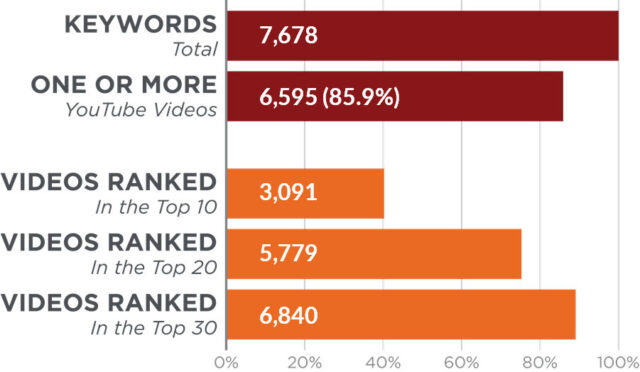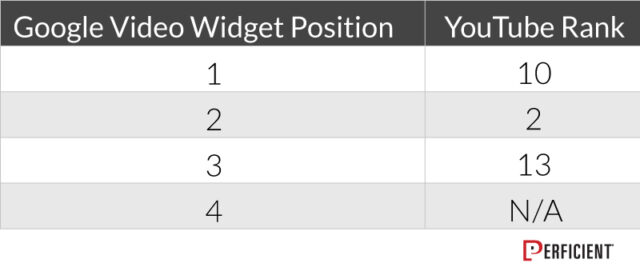Many businesses have included video marketing in their strategy as video plays an incredibly important role in Google search results. How can your videos get high visibility and the traffic that comes with it?
In this episode of the award-winning Here’s Why digital marketing video series, Eric Enge reveals insights from his latest study on how videos rank differently on Google and YouTube and outlines what that means for your video strategy.
Don’t miss a single episode of Here’s Why. Click the subscribe button below to be notified via email each time a new video is published.
Resources
- YouTube Continues to Dominate the Video Results in Google
- YouTube Marketing Resources
- See all of our Here’s Why Videos | Subscribe to our YouTube Channel
Transcripts
Eric: Hey, everybody, Eric Enge here, I’m the Principal for the Digital Marketing Solutions Business Unit at Perficient. And in today’s Here’s Why video, I’m going to outline how the YouTube and Google algorithms for ranking videos differs, and how that impacts your strategy for promoting videos. Firstly, video plays an incredibly important role in the Google search results. Here, for example, is some data that we pulled in the presence of video in the SERPs for home improvement in DIY-related topics.

As you can see, there’s this incredible presence and there are many other markets like this where the importance of video is really paramount. So, how do you earn this level of visibility and the traffic that comes with it?
The first step in that process is to understand that YouTube and Google have different algorithms for ranking videos. For example, the Google results we saw for the query “12 Angry Men,” the Google search results are displayed in the video widget in position three in the search results.

And in there, there were four videos present. And one might assume that these would be the first, second, third, and fourth ranking videos in YouTube if you did the same search there. But that’s not the case, as you see here.
So that already tells us the ranking algorithms are different. But why? The short answer is that the way that YouTube and Google are monetized by Google is different. And therefore, the ranking algorithms for each is tuned to rank videos that will help that monetization the most. For that reason, we now need to talk about what are the ways we should optimize for each platform.
First of all, I’ll start with YouTube. For this, you’ve got to start with a good descriptive file name for the video, you have to choose a compelling title, that’s one of the biggest ones. Select a strong set of related tags, write a detailed and complete description of at least 200 words, you know, give the bot some fodder to chew on. And then of course, place your video in an appropriate category.
But that’s like the basics. It’s sort of equivalent to doing the tech part of SEO right on your website, if you will. To go to the next level, the things you need to think about with your YouTube videos is: Are people going to watch the video to the end? And when they’re finished watching the video, are they going to go on to watching additional videos? The reason why this is important is that YouTube advertising works best for people who spend a long time on the site and watch multiple videos. If your video, or it could be your playlist, by the way, is structured in such a way that it causes people to watch a lot of different videos, YouTube gets to run more ads. That’s good for YouTube, of course it’s also good for users. YouTube lists the results of the videos that feed that I’ll call it “total view time” the best. So, there are many aspects of how you can promote having longer view times, but it starts with creating videos that people want to watch to the end, that also want to cause them to watch more videos. So they want follow on content.
You can even try some tactics like referencing other videos and the like. And be aware the other videos that get pulled in by the user and watched don’t have to be ones published by you or in your channel. What YouTube cares about is that that chain reaction starts happening.
Whereas in contrast, the Google algorithm for ranking videos is quite different. So, keep in mind that the way Google is monetized, it is monetized by clicks on the ads and the search results. But the use modality for Google is when the user arrives there, they want to get what they want fast. So, it’s all about, it used to be about getting them off of Google, but now it’s about just getting the user the answer they want very quickly. The result of this is the monetization there is quite different. And the way that the Google ranking algorithm for ranking videos works is very similar to the ranking algorithm for other web pages. That means you have to complete the basic YouTube optimizations I talked about above (the title, the description, the category, these sorts of things), but it also matters whether you get links to your video.
It’s interesting to see how similar that ranking is to ranking traditional webpages. Ultimately, to maximize your success with your video strategy, you should really try to structure your videos and your video program to address both of the respective algorithms, so you have the potential for ranking in both YouTube and Google.
Don’t miss a single episode of Here’s Why. Click the subscribe button below to be notified via email each time a new video is published.
See all of our Here’s Why Videos | Subscribe to our YouTube Channel

